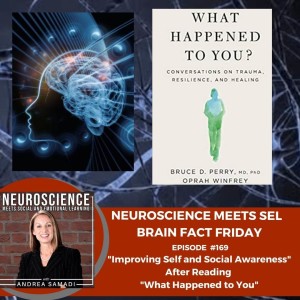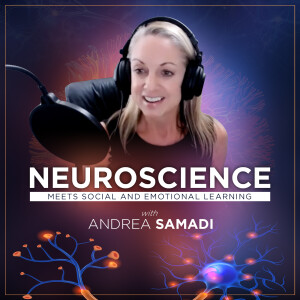
Brain Fact Friday on ”Improving Self and Social-Awareness” After Reading Dr. Perry‘s ”What Happened to You”
 2021-10-07
2021-10-07
Welcome back to the Neuroscience Meets Social and Emotional Learning Podcast for Brain Fact Friday and EPISODE #169 on “Improving Your Self and Social-Awareness” through Dr. Perry’s What Happened to You[i] book and our insightful interview with Dr. Perry and Steve Graner on EPISODE #168.
In Today’s Brain Fact Friday, You Will Learn:
✔︎ How to improve your self and social-awareness after reading this book by thinking about the areas that hit you on an emotional level.
✔︎ Tips for cleaning up your emotions, so that we can be more resilient in the face of adversity.
✔︎ Strategies that you can use right away to apply The Neurosequential Model in your classroom, sports, or other work environments.
After speaking with Dr. Perry and Steve Graner this week on a deep dive of the book he wrote with Oprah Winfrey What Happened to You, I could pick out many important lessons to focus on for this week’s brain fact Friday, and will revisit this interview in future episodes, but if I had to pick just one, it would be to see if you can use the lessons in his book to improve your self and social awareness.
Dr. Perry reminded us that “there’s motor, cognitive, social and emotional capabilities that remain unexpressed in many people” and the purpose of this podcast is to help us as parents, teachers and coaches to understand these SEL competencies in ourselves, and others, with strategies that we can all use to further develop these skills that are not automatic. They require practice. I picked out 6 SEL competencies to focus on in this podcast, and you can go back and listen to the Lessons Learned from our TOP 100 Episodes[ii] that ties in these 6 SEL Competencies as a review.
HOW TO IMPROVE YOUR SELF-AWARENESS:
As you’re reading Dr. Perry’s book, whether it’s your first read, or 21st read, I encourage you to think about what parts give you an emotional charge. Dr. Perry mentioned that he went back and forth from Oprah’s difficult emotional stories, to challenging neuroscientific topics on purpose, to provide a regulating back and forth pace, just like we do with athletics, and high intensity interval training, There was an intentionality to the way the book was written to help us to not become overwhelmed with the content and they do remind us in the beginning, that if we do, to just put the book down, and come back to it. The end of the book powerfully ties in Oprah’s story where she makes sense of her life and relationship with her mother.
With this lesson in mind, can you make sense of your own life by looking for themes of what happened you? What themes came up for you while reading the book? If you haven’t read the book yet, it’s not difficult to think about things that push your buttons, whether at home or in the workplace. Think about your interactions with others and whether these themes show up in your life. Dr. Dan Siegel[iii] talks about being able to “Name it to Tame it” and Marc Brackett from the Yale Center for Emotional Intelligence reminds us that we can unlock the power of our emotions with the “Permission to Feel.”[iv]
Write them down and when you are ready, you can pick the one that stands out the most to you and clean it up. Self-awareness goes a long way here. Go back and listen to Dr. Carolyn Leaf’s BONUS EPISODE[v] on Cleaning Up Your Mental Mess to help you to make sense of whatever it is that comes up for you when reading this book. She has a simple 5-step process that can be used to help you to unpack and make sense of these emotions that we all have, (Dr. Leaf herself uses this process to keep her mind operating optimally) so that emotions are expressed and healed, instead of turned inwards into toxic thoughts that will impact our mental health and well-being. This does take some time to first of all identify emotions that are bothering us, and then making sense of where they came from, to clean them up, but there’s nothing like the feeling of having a clear mind when we are able to do this.
HOW TO IMPROVE YOUR AWARENESS OF OTHERS?
You can also understand others better with this new awareness. Whether you are a teacher in the classroom, a parent, or a coach, being able to have conversations around trauma, and being trauma informed will help you to handle these types of situations, leading to healing and resiliency. I came across an article the day after we recorded this interview with Dr. Perry, written by Allison Cooke Douglas, called “Meeting Children Where They Are”[vi] that will help you with specific ideas to apply the Neurosequential Model if you work with children and youth. Click on the link in the show notes and you can access a 10 Page PDF that will walk you step by step through Dr. Perry’s Model with tips for healing trauma that you can apply to improve the well-being of those children, students or even athletes in your life.
Can you make sense of what happened to you with this new understanding of our brain to bring you clarity for yourself, or how you parent, or teach your students to bring you some peace, like Oprah found at the of the book? I hope this new understanding that Dr Perry’s Neurosequential model offers can help you to better understand yourself and others, bringing you to higher levels of communication, resilience and peace.
The next time you are working, and stress comes your way, think of Dr. Perry’s Neurosequential Model and remember:
STEP 1: All information comes into the brain through the brainstem through our 5 senses, as well as through interoception or “your brain’s perception of your body state.”[vii]
STEP 2: We must remember that our brain was designed to react to the information that comes into our body first, and we must find ways to REGULATE ourselves, or we won’t be able to “reach the cortex” or our REASONING decision-making part of our brain.
STEP 3: Do you have strategies to REGULATE yourself when under stress or pressure at work? If you don’t have time to get outside for a walk when the pressure is too high, can you take some deep breaths and stretch for a minute at your desk?
STEP 4: Only then can we REASON and access the SMART part of our brain.
Dr. Perry also reminded us that creative insights are just not possible when we are under pressure and stressed on a day-to-day basis like when Oprah was recording her television shows. She came up with the idea to write this book when she was not under so much pressure, and her creative mind opened up.
Nothing beats being able to step away from your work, and finding a peaceful place to clear your mind, and access those higher parts of your brain, where we can experience those flashes of creativity and insight that are squashed while under pressure.
I hope you’ve had some AHA Moments with this Brain Fact Friday, improving the way you see yourself and others with a new way of looking a life, through the lens of our powerful brain, where we have the ability to reach incredible heights, and help others to do the same.
I’ll see you next week, with 2 interviews that will tie in our recent learning.
John Harmon will show us how we can map our experiences in the brain (like learning, or playing sports) and how to use this understanding to improve performance while under pressure, and Robin Hills will give us some ideas on how to lead and encourage others to be their best, with strategies for improving our emotional intelligence, with our brain in mind.
See you next week!
FOLLOW ANDREA SAMADI:
YouTube Channel: https://www.youtube.com/c/AndreaSamadi
Website https://www.achieveit360.com/
LinkedIn: https://www.linkedin.com/in/samadi/
Facebook: https://www.facebook.com/Achieveit360com
Neuroscience Meets SEL Facebook Group https://www.facebook.com/groups/2975814899101697
Twitter: https://twitter.com/andreasamadi
Instagram: https://www.instagram.com/andreasamadi/
REFERENCES:
[i] What Happened to You: Conversations on Trauma, Resilience and Healing https://www.amazon.com/What-Happened-You-Understanding-Resilience/dp/1250223180
[ii] Top Lessons Learned from our FIRST 100 Episodes https://andreasamadi.podbean.com/e/lessons-learned-from-our-first-100-episodes/
[iii] Neuroscience Meets Social and Emotional Learning Podcast EPISODE #28 Dr. Daniel Siegel on “Mindsight: The Basis of Social and Emotional Intelligence” https://andreasamadi.podbean.com/e/clinical-professor-of-psychiatry-at-the-ucla-school-of-medicine-dr-daniel-siegel-on-mindsight-the-basis-for-social-and-emotional-intelligence/
[iv] Neuroscience Meets Social and Emotional Learning Podcast EPISODE #22 Mark Brackett on his book “permission to Feel” https://andreasamadi.podbean.com/e/founding-director-of-the-yale-center-of-emotional-intelligence-on-his-new-book-permission-to-feel/
[v]Neuroscience Meets Social and Emotional Learning BONUS EPISODE with Dr. Carolyn Leaf on “Cleaning Up your Mental Mess” https://andreasamadi.podbean.com/e/worldrenownedneuroscientistdr-caroline-leaf-oncleaningup-your-mentalmess5-simplescientifically-proven-stepsto-reduceanxiety-and-toxic-thinking/
[vi] Meeting Children Where They Are: The Neuroseqential Model of Therapeutics October 1, 2021 by Allison Cooke Douglas, MS https://adoptioncouncil.org/publications/meeting-children-where-they-are-the-neurosequential-model-of-therapeutics/
[vii] Interoception: the hidden sense that shapes well-being Sunday August 15, 2021 by David Robson https://amp.theguardian.com/science/2021/aug/15/the-hidden-sense-shaping-your-wellbeing-interoception
More Episodes
Create your
podcast in
minutes
- Full-featured podcast site
- Unlimited storage and bandwidth
- Comprehensive podcast stats
- Distribute to Apple Podcasts, Spotify, and more
- Make money with your podcast
It is Free
- Privacy Policy
- Cookie Policy
- Terms of Use
- Consent Preferences
- Copyright © 2015-2024 Podbean.com







